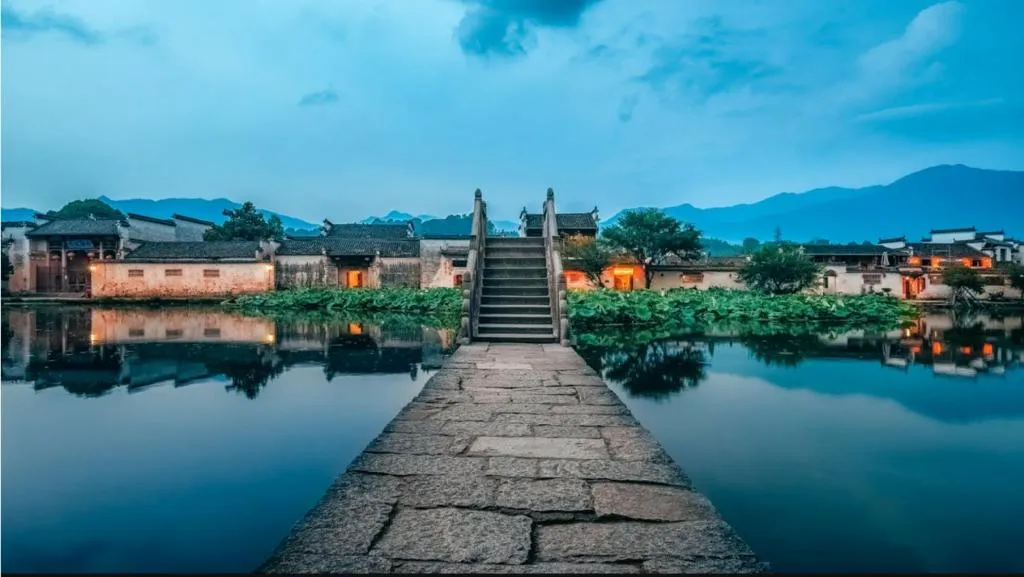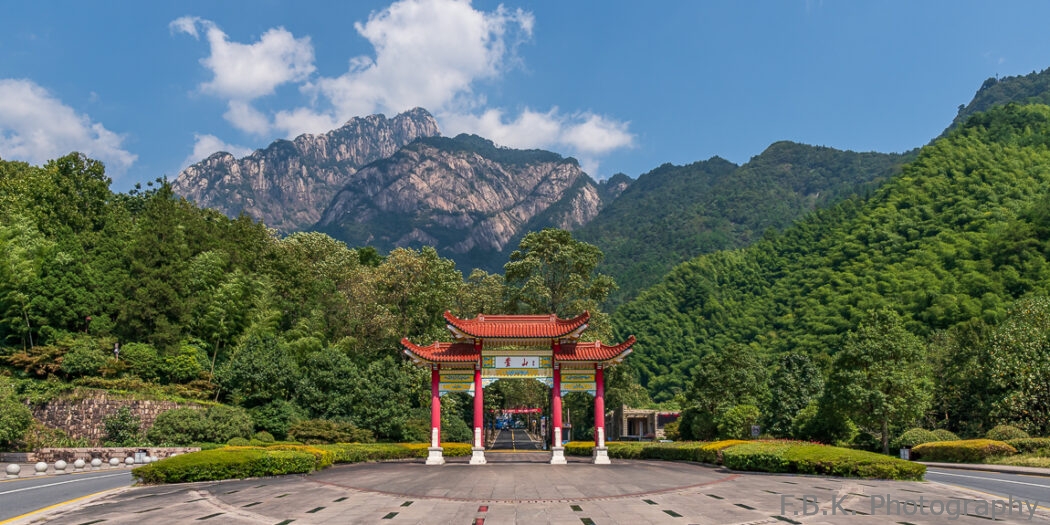🏮 Huangshan: A Majestic Mountain Retreat
Huangshan, also known as the Yellow Mountains, is one of China’s most iconic and picturesque mountain ranges, located in Anhui Province. Famous for its stunning granite peaks, ancient pine trees, hot springs, and mystical clouds, Huangshan has been an inspiration for Chinese painters, poets, and scholars for centuries.
📅 Best Time to Visit Huangshan
- Spring (March-May): The weather is mild and pleasant, making it a perfect time for hiking and exploring the mountain’s scenic beauty.
- Summer (June-August): While it’s warm, mountain temperatures are cooler. It’s also the time for lush vegetation and vibrant landscapes, but expect larger crowds.
- Autumn (September-November): Known for its crisp air and beautiful fall colors, autumn is arguably the best time to visit, with fewer tourists and the most dramatic views.
- Winter (December-February): If you love snow, the snow-covered peaks of Huangshan in winter offer a magical experience, though temperatures can be freezing.
✈️ How to Get to Huangshan
- By Air:
- Huangshan Tunxi International Airport (TXN) connects the region to major cities such as Beijing, Shanghai, and Guangzhou.
- By Train:
- The Huangshan North Railway Station connects to major cities like Shanghai, Hangzhou, and Nanjing, with high-speed trains available.
- By Bus:
- Regular buses run from nearby cities, including Tunxi, the nearest town to the mountain range.
📍 Top Attractions in Huangshan
-
The Yellow Mountains (黄山)
- Huangshan is a UNESCO World Heritage Site, known for its striking granite peaks, ancient pine trees, and flowing clouds. The main peaks of the mountain range are Lotus Peak, Bright Summit, and Celestial Peak.
- The mountain’s landscapes are a perfect mix of natural beauty and mysticism, particularly the famous "Sea of Clouds" that surrounds the peaks during certain times of the year.
-
West Sea Grand Canyon (西海大峡谷)
- This scenic area is famous for its deep valleys, precipitous cliffs, and spectacular viewpoints. The hike through the canyon is an adventurous experience with stunning views.
-
Ancient Pine Trees (古松)
- Huangshan is home to some ancient pine trees, notably the "Guest-Greeting Pine", a symbol of the mountain, and the "Welcoming Pine", which has been depicted in Chinese art for centuries.
-
Hot Springs (温泉)
- Huangshan is known for its natural hot springs, particularly the Tunxi Hot Springs, where visitors can enjoy a relaxing soak with breathtaking mountain views.
-
Huangshan Scenic Area (黄山风景区)
- The Huangshan Scenic Area includes numerous temples, traditional architecture, and walking paths that offer unique perspectives of the mountain.
-
Tunxi Ancient Street (屯溪老街)
- Located at the foot of Huangshan, Tunxi Ancient Street is famous for its traditional architecture, local handicrafts, and street food.
🎟️ Activities to Do in Huangshan
-
Hiking:
- The Huangshan mountain range offers some of the most breathtaking hiking trails in China, with paths ranging from easy walks to challenging treks up to the mountain peaks.
- Popular routes include the Western Sea Grand Canyon and the climb to Lotus Peak for sweeping panoramic views.
-
Photography:
- Huangshan is renowned for its inspiring landscapes. Whether it’s the sunrise over the mountain peaks, the sea of clouds, or the ancient pine trees, it’s a photographer’s paradise.
-
Cable Car Rides:
- To avoid the strenuous climb, you can take a cable car ride to the top and enjoy incredible views from above. There are several cable car routes to different peaks.
-
Visiting Hot Springs:
- After a long hike, relax at the natural hot springs, especially near the Tunxi Hot Springs, which are renowned for their rejuvenating properties.
-
Cultural Experiences:
- Explore the local Anhui architecture and the ancient villages in the region. Visit the Huangshan Museum or take part in local tea ceremonies to experience the area’s cultural heritage.
🏨 Accommodation in Huangshan
Luxury:
- Xihai Hotel – A luxurious hotel located within the Huangshan Scenic Area, offering stunning mountain views and easy access to the mountain’s peaks.
- Huangshan Resort & Spa – Nestled near the mountain, this five-star hotel offers modern amenities, hot springs, and access to hiking trails.
Mid-Range:
- Hongcun Ancient Village Guesthouses – Staying in one of the traditional guesthouses in the Hongcun Ancient Village is a great option for a more authentic experience.
- Tunxi International Hotel – Located in the nearby town of Tunxi, this hotel offers comfortable rooms and a good base to explore the area.
Budget:
- Hostels and Guesthouses – There are plenty of budget-friendly hostels and guesthouses around Tunxi or near the mountain’s base. Expect simple accommodations with basic amenities.
🍜 Food and Restaurants in Huangshan
Must-Try Dishes:
- Huangshan Braised Pigeon (黄山炖鸽): A local specialty, often served with a rich broth.
- Steamed Bamboo Shoots (蒸竹笋): A light, healthy dish made from fresh, local bamboo shoots.
- Huangshan Bean Curd (黄山豆腐): A traditional dish made from bean curd, usually fried with various seasonings.
- Anhui Cuisine (徽菜): Known for its rich, savory flavors, Anhui cuisine features ingredients like wild mushrooms, fresh vegetables, and game meat.
Top Restaurants:
- Huangshan Old Street Restaurants – A variety of local eateries serve authentic Anhui dishes, such as braised chicken and stir-fried bamboo shoots.
- Laojianxi Restaurant – Famous for its regional specialties like braised meats and steamed dishes.
- Xihai Hotel Restaurant – Offers a luxurious dining experience with regional Anhui cuisine and an impressive range of local vegetarian options.
🏮 Local Culture in Huangshan
-
Anhui Architecture:
- The region’s traditional architecture is best seen in ancient villages like Hongcun and Xidi, which are known for their well-preserved houses built with timber and stone.
-
Tea Culture:
- Huangshan is home to the famous Huangshan Maofeng Tea, one of the top Chinese green teas. Visitors can experience tea picking and tea ceremonies in local tea farms.
-
Calligraphy and Painting:
- Huangshan has inspired Chinese artists for centuries. The mountain’s scenic beauty is often depicted in traditional Chinese paintings and calligraphy.
-
Festivals:
- Huangshan celebrates the Chinese New Year and the Dragon Boat Festival with vibrant traditions, including temple fairs, dragon boat races, and cultural performances.
-
Feng Shui Practices:
- The mountain range is deeply connected to Chinese Feng Shui, with its mountain peaks symbolizing balance, power, and harmony.



